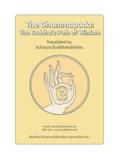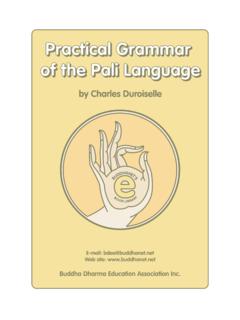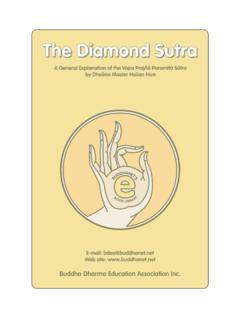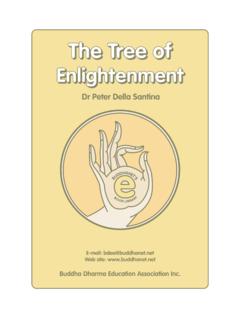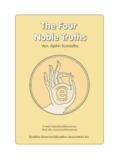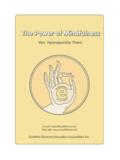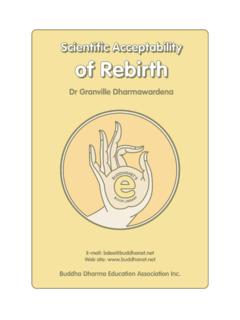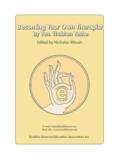Transcription of Ven. Thanissaro, Bhikkhu - BuddhaNet
1 EBUDDHANET'SBOOKLIBRARYE-mail: site: Dharma Education Association thanissaro , BhikkhuDhammapadaA TranslationDhammapadaA Translation2 DDhhaammmmaappaaddaaTABLE OF : ANOTHER TRANSLATION OF THE DHAMMAPADA .. : 2*..243 8*..269 12*..2613 18*..2819 : 24*.. : THE MIND ..3233 37*.. *..3340*.. 43*..34IV : BLOSSOMS ..3544 45*.. 48*.. *..3754 56*..3857*..3858 : FOOLS .. *..4172 : THE WISE ..4376 *.. *.. 89*..46 VII : ARAHANTS .. 93*..4894 96*..4897*.. : THOUSANDS ..50100 102*..50103 108*..5210 : *..5612 *..57127 : THE ROD ..58129 *..6114 : *..63153 154*..64155 : SELF ..65157*..6515 *..6616 *..67165*..67166*..67 XIII : WORLDS ..6816 *..6817 *..7017 *..70 XIV : 185*..72186 192*..7419 196*..75XV : : DEAR *..79210 *..81219 : 234*.
2 85 XVIII : 238*..8723 *..87241 255*..90 XIX : THE JUDGE ..91256 257*..91258 259*..91260 265*..93266 269*..9427 272*..94XX : THE *..95274 276*..96277 285*..98286 289*..99XI : 293*..101294 295*..101296 301*..10230 *..10330 : HELL ..10430 : ELEPHANTS ..10732 *..10832 330*..109331 : *..11233 340*..112341*..113342 343*..113834 347*..114348*..115349 350*..115351 352*..116353*..116354*..11635 : MONKS ..118360 361*..11836 *..11836 *..120369*..120370*..12037 *..12338 : BRAHMINS ..124383*..124384*..124385*..12438 *..125389*..126390*..12639 *..126393 394*..12739 *..12739 *..12839 *..12840 *..12940 *..132412*..13241 *..13542 *..135 HISTORICAL NOTES: THE TEXT & THE PAGES (notes for printing) ..18310 Preface:Another translation of the DhammapadaMany other English translations are already available the fingers of at least five people would be needed tocount them so I suppose that a new translation has tobe justified, to prove that it s not just another one.
3 Indoing so, though, I d rather not criticize the efforts ofearlier translators, for I owe them a great deal. Instead,I ll ask you to read the Introduction and HistoricalNotes, to gain an idea of what is distinctive about theapproach I have taken, and the translation itself, which Ihope will stand on its own merits. The original impulsefor making the translation came from my conviction thatthe text deserved to be offered freely as a gift ofDhamma. As I knew of no existing translations availableas gifts, I made my explanatory material is designed to meet with theneeds of two sorts of readers: those who want to read thetext as a text, in the context of the religious history ofBuddhism viewed from the outside and those whowant to read the text as a guide to the personal conductof their lives. Although there is no clear line dividingthese groups, the Introduction is aimed more at thesecond group, and the Historical Notes more at the End Notes and Glossary contain material that shouldbe of interest to both.
4 Verses marked with an asterisk inthe translation are discussed in the End Notes. Pali terms as well as English terms used in a special sense, suchas effluent, enlightened one, fabrication, stress, andUnbinding when they appear in more than one verse,are explained in the addition to the previous translators and editors fromwhose work I have borrowed, I owe a special debt ofgratitude to Jeanne Larsen for her help in honing downthe language of the translation. Also, John Bullitt,Charles Hallisey, Karen King, Andrew Olendzki, RuthStiles, Clark Strand, Paula Trahan, and Jane Yudelmanoffered many helpful comments that improved thequality of the book as a whole. Any mistakes thatremain, of course, are my own BhikkhuMetta Forest MonasteryValley Center, CA 92082-1409 December, 199712 IntroductionThe Dhammapada, an anthology of verses attributedto the Buddha, has long been recognized as one of themasterpieces of early Buddhist literature.
5 Only morerecently have scholars realized that it is also one of theearly masterpieces in the Indian tradition of kavya, orbelles translation of the Dhammapada is an attempt torender the verses into English in a way that does justiceto both of the traditions to which the text it is tempting to view these traditions asdistinct, dealing with form (kavya) and content(Buddhism), the ideals of kavya aimed at combiningform and content into a seamless whole. At the sametime, the early Buddhists adopted and adapted theconventions of kavya in a way that skillfully dovetailedwith their views of how teaching and listening played arole in their path of practice. My hope is that thetranslation presented here will convey the sameseamlessness and an example of kavya, the Dhammapada has a fairlycomplete body of ethical and aesthetic theory behind it,for the purpose of kavya was to instruct in the highestends of life while simultaneously giving delight.
6 Theethical teaching of the Dhammapada is expressed in thefirst pair of verses: the mind, through its actions(kamma), is the chief architect of one s happiness andsuffering both in this life and beyond. The first threechapters elaborate on this point, to show that there aretwo major ways of relating to this fact: as a wise person,who is heedful enough to make the necessary effort to13train his/her own mind to be a skillful architect; and as afool, who is heedless and sees no reason to train work as a whole elaborates on this distinction,showing in more detail both the path of the wise personand that of the fool, together with the rewards of theformer and the dangers of the latter: the path of the wiseperson can lead not only to happiness within the cycle ofdeath and rebirth, but also to total escape into theDeathless, beyond the cycle entirely; the path of the foolleads not only to suffering now and in the future, butalso to further entrapment within the cycle.
7 The purposeof the Dhammapada is to make the wise path attractiveto the reader so that he/she will follow it for thedilemma posited by the first pair of verses is not one inthe imaginary world of fiction; it is the dilemma inwhich the reader is already placed by the fact of make the wise path attractive, the techniques ofpoetry are used to give savor (rasa) to the Indian aesthetic treatises devoted a great deal ofdiscussion to the notion of savor and how it could beconveyed. The basic theory was this: Artisticcomposition expressed states of emotion or states ofmind called bhava. The standard list of basic emotionsincluded love (delight), humor, grief, anger, energy, fear,disgust, and astonishment. The reader or listener exposedto these presentations of emotion did not participate inthem directly; rather, he/she savored them as an aestheticexperience at one remove from the emotion. Thus, thesavor of grief is not grief, but compassion.
8 The savor ofenergy is not energy itself, but admiration for savor of love is not love but an experience ofsensitivity. The savor of astonishment is a sense of themarvelous. The proof of the indirectness of the aestheticexperience was that some of the basic emotions weredecidedly unpleasant, while the savor of the emotion wasto be a work of art might depict many emotions, andthus like a good meal offer many savors for thereader/listener to taste, one savor was supposed todominate. Writers made a common practice ofannouncing the savor they were trying to produce,usually stating in passing that their particular savor wasthe highest of all. The Dhammapada [354] statesexplicitly that the savor of Dhamma is the highest savor,which indicates that that is the basic savor of the aesthetic theory lists the savor of Dhamma, orjustice, as one of the three basic varieties of the heroicsavor (the other two deal with generosity and war): thuswe would expect the majority of the verses to depictenergy, and in fact they do, with their exhortations toaction, strong verbs, repeated imperatives, and frequentuse of the imagery from battles, races, and , in the Buddhist sense, implies more than the justice of Dhamma in aesthetic theory.
9 However, thelong section of the Dhammapada devoted to TheJudge beginning with a definition of a good judge,and continuing with examples of good judgment shows that the Buddhist concept of Dhamma has roomfor the aesthetic meaning of the term as theory also holds that the heroic savor should,especially at the end of a piece, shade into themarvelous. This, in fact, is what happens periodically15throughout the Dhammapada, and especially at the end,where the verses express astonishment at the amazingand paradoxical qualities of a person who has followedthe path of heedfulness to its end, becoming pathless [92 93; 179 180] totally indescribable, transcendingconflicts and dualities of every sort. Thus thepredominant emotions that the verses express in Pali and should also express in translation are energy andastonishment, so as to produce qualities of the heroic andmarvelous for the reader to savor. This savor is thenwhat inspires the reader to follow the path of wisdom,with the result that he/she will reach a direct experienceof the true happiness, transcending all dualities, found atthe end of the aesthetic theory lists a variety of rhetoricalfeatures that can produce savor.
10 Examples from theselists that can be found in the Dhammapada include:accumulation (padoccaya) [137 140], admonitions(upadista) [47 48, 246 248, et. al.], ambiguity(aksarasamghata) [97, 294 295], benedictions (asis)[337], distinctions (visesana) [19 20, 21 22, 318 319],encouragement (protsahana) [35, 43, 46, et. al.],etymology (nirukta) [388], examples (drstanta) [30],explanations of cause and effect (hetu) [1 2],illustrations (udaharana) [344], implications (arthapatti)[341], rhetorical questions (prccha) [44, 62, 143, et. al.],praise (gunakirtana) [54 56, 58 59, 92 93, et. al.],prohibitions (pratisedha) [121 122, 271 272, 371,et. al.], and ornamentation (bhusana) [passim].Of these, ornamentation is the most complex, includingfour figures of speech and ten qualities . The figures ofspeech are simile [passim], extended metaphor [398],16rhyme (including alliteration and assonance), and lamps [passim]. This last figure is a peculiarity of Pali a heavily inflected language that allows, say, oneadjective to modify two different nouns, or one verb tofunction in two separate sentences.
